Speech Business Investment in Australia
One of the ongoing themes in the global economy since the financial crisis has been the long-lasting paucity of business investment spending. This has been despite conditions that, in the past, have been very favourable for investment spending, such as low borrowing rates, strong corporate balance sheets and solid profitability.
In Australia, the story has been quite different. Investment spending here has been at a historically high level over much of the past decade. This has been primarily due to the strength of investment in the resources sector, which reached its highest share of activity in more than a century. So, unlike in other countries, there has been a significant addition to the capital stock in Australia over the past decade. We are seeing the fruits of that investment in the strong growth in resource exports.
Today I would like to compare and contrast the investment experience in Australia with that of other countries. I will also compare and contrast investment in the resources sector in Australia with investment in the rest of the economy, where the experience is more similar to that elsewhere in the world.
As we are almost at the end of the resource investment cycle, stronger growth in investment in other sectors is important for future additions to the capital stock in Australia. I will spend some time discussing the recent history of investment in this part of the economy, drawing insights from a recently available dataset that provides highly disaggregated information on the business sector.
Mining Investment
In Australia, investment spending as a share of the economy rose to a multi-decade high around 2012–13 (Graph 1). This stands in stark contrast to the experience in nearly every other advanced economy as well as most emerging economies, with China being a noteworthy exception (Graph 2).
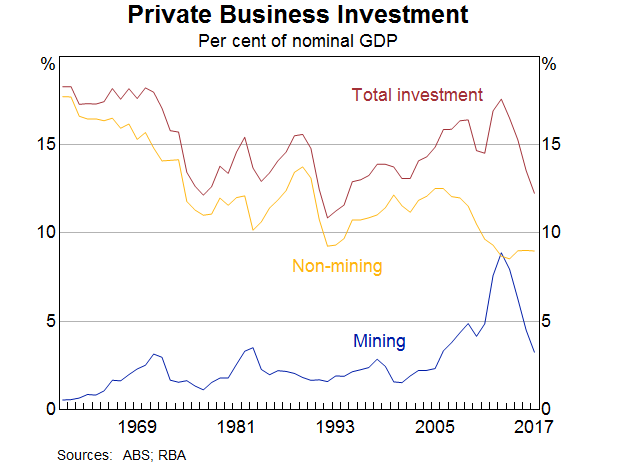
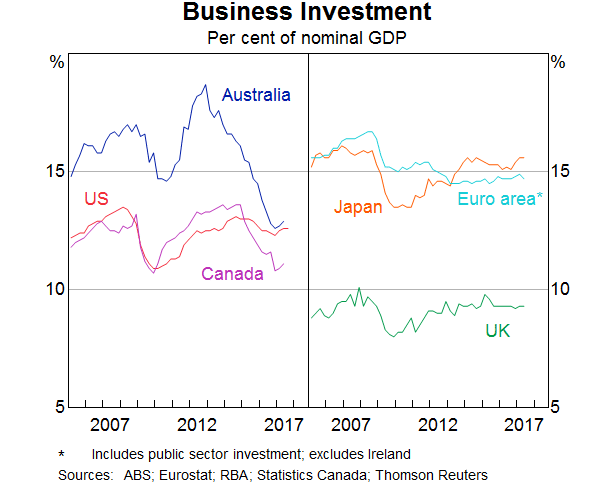
Much of that outcome was clearly a result of the record level of investment spending in the mining sector. Investment spending in the mining sector rose from around 2 per cent of GDP in the early 2000s, where it had been for much of the previous five decades to peak at around 9 per cent of GDP in 2012/13. Or, to put that in dollar terms, investment spending in the mining sector in 2006/07 totalled $41 billion and rose to a peak of $136 billion in 2012/13.
The reasons for the huge rise in investment spending in the mining sector have been well documented. In the case of iron ore and coal, it was a response to the large rise in commodity prices through the 2000s, predominantly driven by the emergence and strong resource-intensive growth of China. Investment spending to increase capacity in the iron ore and coal industries accounts for around 40 per cent of the spending over the past decade (Graph 3). A larger share has been spent in the liquefied natural gas (LNG) sector, which is not only a China story, with a large part of LNG exports also destined for Japan and Korea.
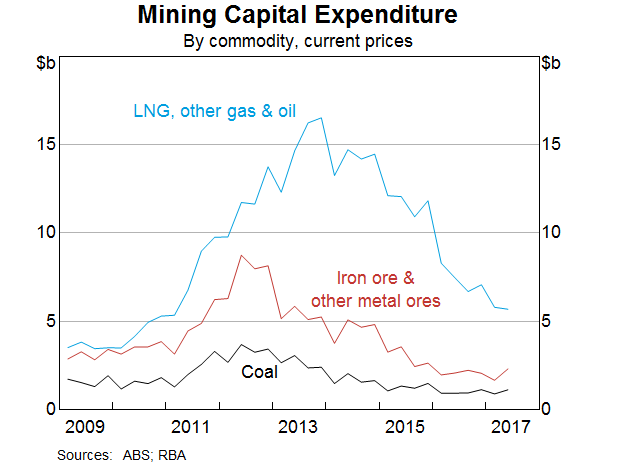
Many of these investment decisions, particularly in iron ore and coal, took place well before commodity prices peaked. These projects are large with very long lead times; LNG projects often take more than five years to complete. The investment decisions were predicated on prices much lower than those subsequently seen through the height of the commodity price boom. Prices for iron ore and coal in Australian dollar terms today still compare favourably with the level assumed when commissioning these projects.
Since the peak in 2012/13, investment spending in the resource sector has declined as projects have been completed. As they have been completed, production has been ramped up and we are now seeing the benefits of that with large increases in resource exports. Since 2007, iron ore export volumes have more than doubled and coal export volumes have increased by 70 per cent (Graph 4). The Bank's assessment is that the vast bulk of the increase in production for these commodities is now behind us, with only a project or two still to be completed. LNG is in a much earlier stage of the process. LNG exports have risen by 75 per cent over the past couple of years and our expectation is that, over the next couple of years, exports are likely to increase by a further one-third. At the end of that, LNG exports are likely to be two-thirds of the value of iron ore exports, and account for around 15 per cent of total exports from Australia.
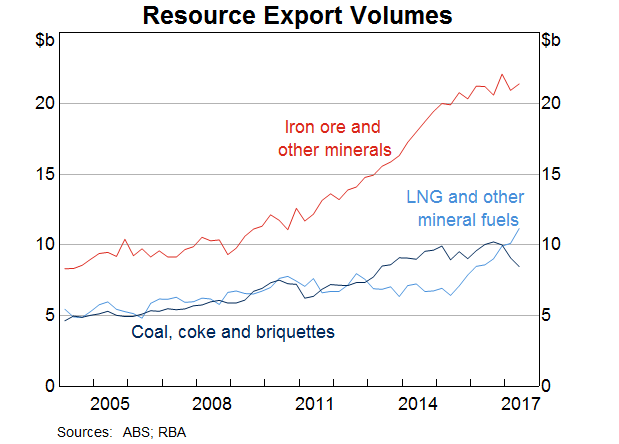
With the increase in productive capacity of the resources sector, and hence supply both here and in other parts of the world, naturally enough, prices have declined from their extremely high levels earlier this decade. It is interesting to think about the commodity price dynamics going forward. Through much of the 2000s, the growth in demand vastly outstripped the growth in supply, causing the extraordinarily large price increases. Then, over much of the past five years or so, the growth in supply has considerably outstripped the growth in demand, and prices have fallen considerably. But, looking forward, most obviously in the case of iron ore, there is not so much supply to come on to the market, so the commodity price dynamics are very much dependent on the demand side of the market. In the near term, the prices of coal and iron ore are primarily affected by Chinese demand. There is analysis on this issue in a box in the recently published Statement on Monetary Policy. It is worth keeping in mind the simple point that maintaining the level of demand around current levels will support prices if there is no material change in supply. If demand declines then prices will fall, but, if it grows, then prices are likely to rise again.
Following the significant addition to productive capacity from these large projects over the past decade, there has been a notable lack of exploration spending in recent years. This means there is not much prospect of any material increase in investment spending in the period ahead. As a result, our expectation is that investment spending in the resources sector will bottom out just above 2 per cent of GDP and stay at roughly that level for quite a while. That is, companies will primarily just be undertaking replacement spending to maintain existing production capacity. This outlook is also very much consistent with the information we get from the Bank's business liaison program, and is also evident in the Australian Bureau of Statistics (ABS) capital expenditure survey.
So what is the primary explanation for why investment in the mining sector has been so much stronger than in the non-mining sector and so much stronger than investment in other advanced economies? Fairly obviously, it is because mining companies expected that demand in the future was going to be strong. The other factors affecting these investment decisions were generally comparable with those in other parts of the economy. Funding was as cheap and readily available; uncertainty was not obviously any more or less. Indeed, the long horizons for these projects meant that uncertainty was at least as large as in other sectors.
Non-mining Business Investment
Now I will turn to investment in the non-mining sector. The sharp contraction in business investment during the financial crisis, and the subsequent weak recovery, has primarily been a phenomenon of advanced economies.[1] A large body of literature has attempted to explain the underwhelming pick-up in investment and has attributed it to a range of factors, which I will spend some time discussing.
Australian non-mining investment (in real terms) is currently around 17 per cent higher than it was at Q1 2008. By way of comparison, investment spending in the US has increased by about the same amount, while in the UK it has risen by 13 per cent, by 3 per cent in Japan but in the euro area it is still 4 per cent lower than in 2008.
In all of these cases, this is a disappointingly low level of investment spending.
What has been holding investment back? There are a number of possible explanations, some of which I will discuss here.[2] In doing so, in a number of cases I will use evidence from a new database from the ABS called BLADE (Business Longitudinal Analytical Data Environment).[3]
The BLADE database contains matched administrative and ABS survey data for (almost) all Australian firms with data available from 2002 to 2015. It includes annual data on capital purchases, sales, capital stock, wages and a number of other variables. The data on capital purchases are well aligned with investment spending in the national accounts and coverage is considerably larger than that in the ABS capital expenditure survey (Graph 5).[4]
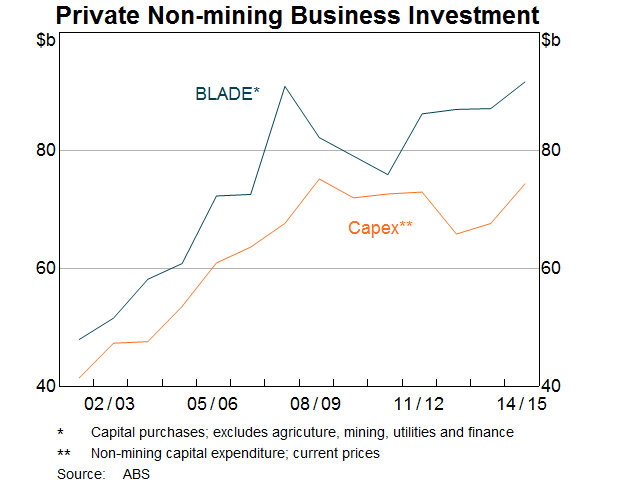
Weak economic growth
An obvious candidate to explain the post-crisis behaviour of investment is weak aggregate demand. Research finds that much of the weakness in global investment since the crisis can be explained by slower economic growth.[5] However, when we look at this in Australia, while the explanation clearly has a lot of attraction, there is less clear-cut evidence for non-mining business investment. Investment spending in the non-mining sector has been even weaker than predicted by our standard aggregate model. Similarly, we have examined firm-level data and found that corporate investment has been consistently weaker than would be predicted based on past relationships with Tobin's Q (a forward-looking measure of investment opportunities).
These results could mask heterogeneity across firms of different sizes (Graph 6). For example, while the post-crisis weakness in non-mining investment has been broad based across large and small businesses, our analysis using BLADE data shows that, for large firms, this can be mainly explained by weakness in demand. In contrast, investment by small firms has been unusually weak since the crisis, relative to current demand.
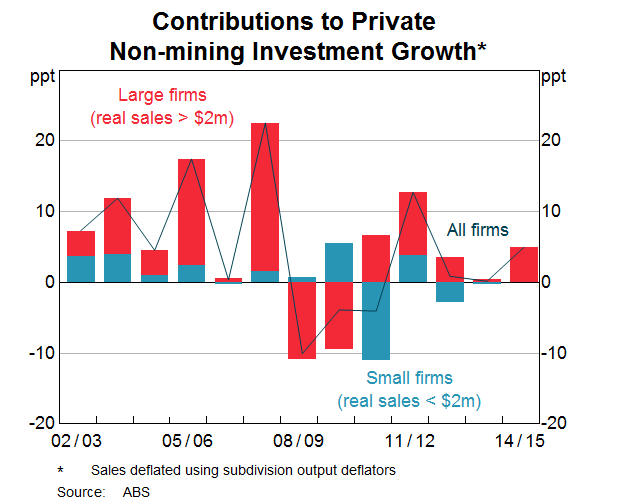
Expectations of weak future conditions are plausibly restraining business investment even more than current conditions. Until recently, Bank liaison pointed to businesses being reluctant to invest until they saw a sustained pick-up in demand. Similarly, we have some evidence that weaker corporate sentiment is holding back investment for both US and Australian companies, using estimates of corporate sentiment based on the share of ‘negative’ words in each company's annual report.
More recently, though, investment intentions in business surveys and the Bank's liaison contacts have increased alongside improved expectations for demand. This is true in Australia, but particularly so in other countries, most prominently in the US.
There may be a cross-border aspect to the weakness of global investment over the past decade. Investment decisions taken by multinationals may be influenced by their assessment of conditions in their home market, particularly to the extent that imposes funding constraints on their global operations. One theme that has been present in our business liaison is that, notwithstanding the relative strength of the Australian economy, a number of multinationals were making investment decisions on a global basis rather than a local basis. Again, there are signs that the generalised improvement in business sentiment is leading to a global reassessment of investment decisions and a synchronised global upswing in investment spending.
Headwinds from the mining investment boom
While the mining investment boom was in progress, there were very apparent positive spillovers to non-mining business investment in Western Australia and Queensland. At the same time, this was creating headwinds to investment in the rest of the country, particularly New South Wales and Victoria, not least because of the very elevated level of the exchange rate at the peak of the commodity boom.[6] One area of the economy where the negative effect of the high exchange rate on investment was evident was tourism. Our liaison with the tourism sector highlights that the low level of investment while the exchange rate was at its peak is having an impact on the industry now that tourism demand has increased with the lower Australian dollar.
As these forces have reversed, non-mining investment in Queensland and Western Australia has declined along with the decline in mining investment, while it has risen noticeably in New South Wales and Victoria.
These spillovers are evident in the BLADE database. The data show that investment by firms in mining-exposed industries in Queensland and Western Australia has declined sharply since 2012, whereas investment by firms in other industries has remained broadly unchanged. That is, the effect of the mining investment rise and fall has been larger than we initially anticipated because of the spillovers to other parts of the local economies.
Firms' and shareholders' reduced appetite for (and assessment of) risk
Investment could be held back if firms have become more risk averse or if they have reassessed the likelihood of bad outcomes. While it is difficult to differentiate between these two, there are some signs that suggest that one or both have changed post-crisis. Liaison suggests some managers are less willing to take risks, and have tightened investment criteria since the crisis. Companies have reduced their gearing and increased their cash holdings, and hurdle rates remain relatively high despite falls in borrowing rates.[7]
Related to the latter point is that there are some indications that the stock market is rewarding cost reduction rather than investment spending where the payoffs are multi-year rather than immediate. That is, the risk aversion may be coming more from shareholders than a company's executive or board. There appears to be a desire to have ‘excess’ capital returned to shareholders through buybacks and dividends, rather than utilising that capital for investment with uncertain returns (Graph 7).[8]
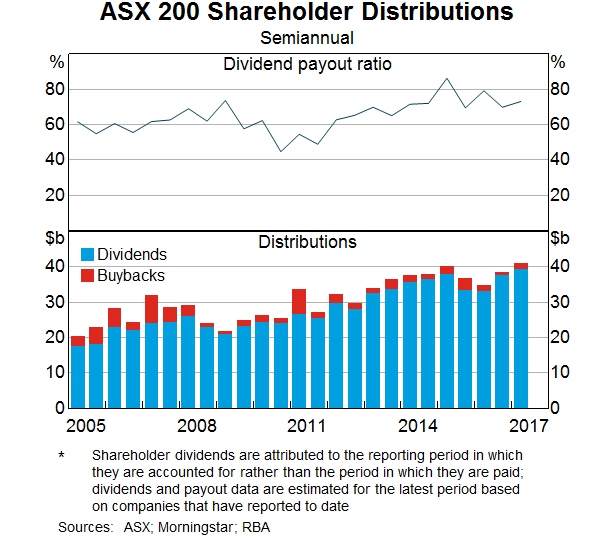
Note that cost reduction does not necessarily imply lower investment. Achieving greater automation or process efficiencies is quite likely to require some amount of capital spending.
Heightened uncertainty
Several studies suggest that heightened uncertainty has weighed on investment in a number of countries.[9] Indeed, construction of measures of uncertainty has become something of a cottage industry. Our own work has found some evidence of a negative relationship between uncertainty and investment but most measures of uncertainty for Australia have been at relatively low levels in recent years.[10] That said, uncertainty is not observable, and different uncertainty measures may have different statistical relationships with investment.
Tighter financial conditions
Financing constraints have been found to play a role in explaining weak investment outcomes in a number of countries.[11]However, liaison with larger businesses suggests that the cost and availability of finance is generally not weighing on investment in Australia. Moreover, aggregate indicators of borrowing costs are at low levels.
However, aggregate indicators of the availability of finance and borrowing costs hide a great degree of heterogeneity (Graph 8).[12] While finance is readily available for large companies, either through the banking system or through capital markets, our liaison with smaller enterprises indicates that the availability of finance is a much more binding constraint. My colleague Chris Kent will talk about this in more detail next month.
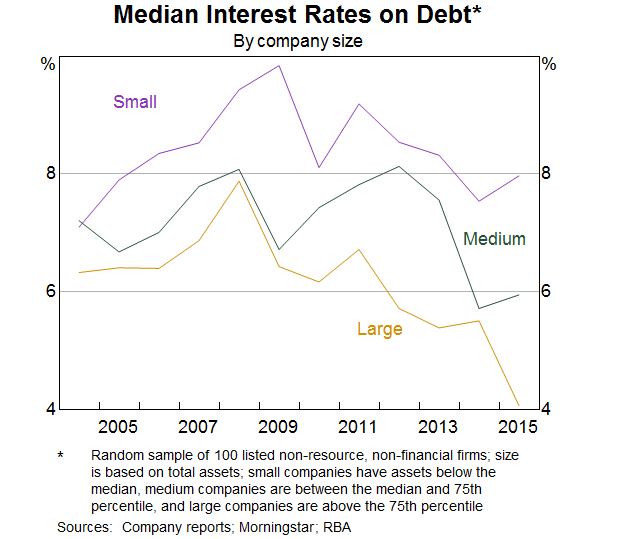
Changes in the composition of output
Another possible explanation is that non-mining investment is lower because the steady-state investment-to-GDP ratio is lower than in the past. (The steady-state ratio is the ratio that the economy should converge to once all cyclical factors have dissipated.) These arguments can broadly be split into two categories: a structural shift in the economy towards services (and other less capital-intensive sectors); and changes in other economic factors that determine the steady-state investment ratio.
The main challenge for these theories is to explain why structural factors only emerged as important in restraining investment in the post-crisis period.
If relatively less capital-intensive sectors become a larger share of the economy, the steady-state level of investment ratio is likely to be lower. However, our analysis suggests that the capital intensity of industries varies substantially within each of the goods and services sectors. That is, the decline in the investment share of output is largely due to changes in investment within industries, rather than changes in the sectoral composition of output.
The Current Conjuncture
That said, of late, there have been signs of life in investment spending outside the resources sector. In particular, following some data revisions that I referred to recently, it now appears that there has been a solid upward trajectory in non-mining business investment over the past couple of years.[13]
Where has the growth been? The annual national accounts data indicate that much of the growth in business investment in recent years has been in the services sector, including industries such as health, information, media and telecommunications (Graph 9). Service industries are not necessarily less capital intensive.
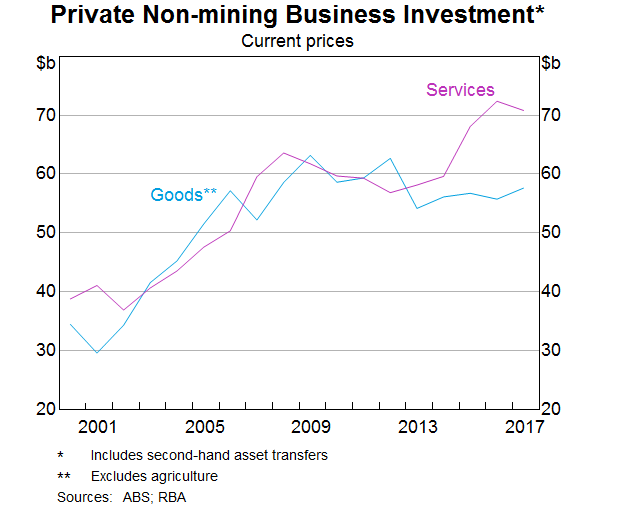
The services sector does not have good coverage in the ABS capital expenditure survey, particularly health and education. The capital expenditure survey covers only around half of investment spending in the non-mining sectors. So it is not a particularly comprehensive guide to either the current level or outlook for aggregate non-mining investment.
The other area of investment that has been robust of late has been in those parts of the economy associated with infrastructure spending. There has been a pick-up in growth of public investment in recent years. A share of these projects have been completed by the private sector on behalf of the public sector, some of which have been recorded as private investment in the national accounts as the work occurs.[14] This has boosted investment growth, both as a direct consequence of the infrastructure spending and, increasingly, in spillovers to other parts of the economy.
Conclusion
A common global theme in the post-crisis environment has been the lack of investment. I have presented three points around that in the Australian context.
- First, there has not been a lack of investment in Australia over the past decade. Indeed, it has been close to the opposite, with investment reaching a multi-decade peak.
- Second, the strength of investment spending in Australia has been clearly associated with the mining industry and the spillovers (both positive and negative) of that to investment in other parts of the economy have been greater than we thought ex ante.
- Third, in reviewing possible explanations for why investment in the non-mining sector in Australia has been weak, the most powerful reason boils down to firms' expectations of future demand, otherwise known as animal spirits. Mining investment was strong because expectations for future demand were high and there wasn't that much uncertainty around that expectation. Expectations of demand elsewhere have not been strong.
We are now seeing signs of that dynamic changing around the world and in Australia. With any luck, it will be sustained. This will be timely for the Australian economy as the mining investment story draws to its close.
Endnotes
Thanks to Gianni La Cava and Jonathan Hambur for their assistance. [*]
IMF (International Monetary Fund) (2015), ‘Private Investment: What's the Holdup?’, World Economic Outlook: Uneven Growth – Short- and Long-term Factors', Chapter 4, April, pp 111–143. See also Gutiérrez G and T Philippon (2016), for an examination of the relative weakness in non-mining investment in the United States <http://pages.stern.nyu.edu/~tphilipp/papers/QNIK.pdf>. [1]
A recent intergovernmental review explores some of the factors influencing investment in the non-mining sector in recent years. For more information, see <http://research.treasury.gov.au/external-paper/intergovernmental-review-of-business-investment/>. [2]
For more information on the BLADE database, see <https://industry.gov.au/Office-of-the-Chief-Economist/Data/Pages/Business-Longitudinal-Analysis-Data-Environment.aspx>. [3]
The results of these studies are based, in part, on ABR data supplied by the Registrar to the ABS under A New Tax System (Australian Business Number) Act 1999 and tax data supplied by the ATO to the ABS under the Taxation Administration Act 1953. These require that such data are only used for the purpose of carrying out functions of the ABS. No individual information collected under the Census and Statistics Act 1905 is provided back to the Registrar or ATO for administrative or regulatory purposes. Any discussion of data limitations or weaknesses is in the context of using the data for statistical purposes, and is not related to the ability of the data to support the ABR or ATO's core operational requirements. Legislative requirements to ensure privacy and secrecy of this data have been followed. Only people authorised under the Australian Bureau of Statistics Act 1975 have been allowed to view data about any particular firm in conducting these analyses. In accordance with the Census and Statistics Act 1905, results have been confidentialised to ensure that they are not likely to enable identification of a particular person or organisation. [4]
See for example IMF (2015). [5]
Though it is worth noting that a higher exchange rate makes imported investment goods cheaper. [6]
Kent C (2014), ‘Non-mining Business Investment – Where to from here?’, Address to the Bloomberg Economics Summit, Sydney, 16 September. Lane K and T Rosewall (2015), ‘Firms' Investment Decisions and Interest Rates’, RBA Bulletin, June, pp 1–8. [7]
See Bergmann M (2016), ‘The Rise in Dividend Payments’, RBA Bulletin, March, pp 47–56. [8]
Banerjee R, J Kearns and M Lombardi (2015), ‘(Why) Is Investment Weak’, available at <https://www.bis.org/publ/qtrpdf/r_qt1503g.htm>, BIS Quarterly Review, March. Fay R, J Guenette, M Leduc and L Morel (2017), ‘Why is Global Business Investment so Weak? Some Insights from Advanced Economies’, available at <http://www.bankofcanada.ca/wp-content/uploads/2017/05/boc-review-spring17-fay.pdf>, Bank of Canada Review, Spring. [9]
Moore A (2016), ‘Measuring Economic Uncertainty and Its Effects’, RBA Research Discussion Paper No 2016-01. [10]
See Fay et al (2017). [11]
Hambur J and G La Cava (forthcoming), ‘Firming Up Our Understanding: Firm-level Interest Rates and Corporate Investment’, RBA Research Discussion Paper. [12]
Debelle G (2017), ‘Uncertainty’, Speech at the 7th Warren Hogan Memorial Lecture, Sydney, 26 October. [13]
Once the work is complete there can be a transfer of ownership recorded between the private and public sector. [14]
